|
by Amy R Singer
This column is about my journey in learning to spin without wool or any other 4-legged animal fiber, using the same tools as everyone else.
Bamboo won't bite.
|
Long-hoarded bamboo roving finally becomes yarn. I swear I heard angels singing when I plied it.
|
As a very new spinner, I'm used to being the one oogling the work of others. In fact, it was pure envy that got me wanting to spin in the first place!
But something strange started while I was at SOAR last October [read more about that here].
The first stuff I was able to spin on my wheel – a hand-carded hemp/bamboo blend [see the beige stuff in the pic below] -- wasn't very enviable, but I wasn't trying to inspire envy. I just wanted to make yarn, and that coarse, hairy stuff was, without question, yarn!
By the 2nd day of class, I headfirst jumped into the big bag of bamboo roving I'd been hoarding forever and started to spin it. I took what Maggie had taught me on the rougher stuff and applied it to the smooth, silky roving now running through my fingers.
|
Hand-carded hemp/bamboo blend,
spun from rolags, 2 ply.
|
That second day was a series of subtle improvements to my brand-new spinning skills. I made yarn. Made more yarn. Made slightly better yarn. Was able to keep making slightly better yarn for a sustained period of time. Started to make more consistent yarn. Kept making that consistent yarn until the roving ran out.
Then the strangest thing happened. Spinners started oogling my work. New spinners and some with more experience than I have rings around my tree. Are you kidding me?
But it was true. I was spinning stuff that they, as wool-friendly spinners, hadn't even tried to spin. Or had tried to spin and didn't like it. Or didn't like how the yarn was turning out compared to the wool they knew so well. So they wrote it off as too hard, too fiddly, not something they'd waste precious spinning time on. I can't blame them.
See, this is exactly the thing I knew I'd face when I decided to learn to spin. I knew what everyone said about spinning slippery fibers like silk and bamboo and soy and corn – it's hard. Harder. But I also knew I wouldn't be troubled by a pesky muscle memory of easy-spinning Bluefaced Leicester tainting my opinion of the fibers I really wanted and needed to spin. How can something be harder than something else if the something else isn't something you can do? The thing you want to learn is as hard as it is, period. No comparison. It's just spinning bamboo, not "spinning bamboo, even though it's so much more difficult than the wool I just spun and I will never get the hang of this slippery bamboo and I give up."
So let this very new spinner tell it to you straight: If I can spin bamboo, it's not hard to spin bamboo. It's just different.
And now, a brief interlude for photographic proof:

Newbie handspun bamboo singles.
Some too twisty, some underspun [not too much of that, though], some just right.
 All plied up!
All plied up!
The first thing I noticed in the learn-to-spin class with Maggie was that woolen spinning – which she taught us first – was really hard for me. I kept wanting to do a short pinch-and-pull forward draw. I managed to spin the hemp/bamboo sort of wooleny, but it was nothing to write home about.
Then Maggie taught us worsted spinning, and you could nearly hear the bell going off in my head. THAT was how I was spinning the slippery stuff because that's how it's easiest to spin it. At least for me. Keeping the fibers aligned, tight, neat, with lots of twist – that works really well with slippery stuff. No wonder I wanted to do it instinctively.
|
Think about the bamboo plant: it's very tall! Surely it must, then, have very long fibers!
Well, it does have reasonably long fibers, compared to other non-wools like cotton. Bamboo fiber isn't anything like long-staple hemp or linen -- it doesn't grow as tall fibers inside a tough stalk. Instead, bamboo stalks are mushed up into a sort of goopy slurry which is mixed with chemicals and then extruded through spinnerets to make the bamboo fiber. The mill controls the fiber length, and since we like our bamboo sheets and underwear and yarn smooth and silky, they make longer fibers for us.
That means you're already way ahead when you pick up the bamboo roving to spin.
What's missing? The little scales that naturally occur on animal fibers, that's what. |
So let's talk about spinning slippery stuff, shall we?
The first thing I need you to know is that you'll do much better if you pretend you're me. Imagine that you haven't spun wool. Imagine that you don't know anything but worsted-style spinning.
Pre-draft the roving, just a little. You don't want to reduce the width of the roving to its final width, because you'll be doing that as you spin. But you don't want it fresh out of package, either. Having more fibers than you need available to draft from as you spin means you run less risk of the fibers slipping out of your grasp and having one of those expletive moments as the yarn becomes microscopically thin and breaks.
One of the favorite things Maggie set me up with in class was a slightly coarse linen leader. It's a fabulous fiber to use for any non-wool, and bamboo is no exception. I'd recommend you do the same with your non-wool spinning. You'll find the bamboo grabs around the leader very well and locks in place quickly.
With the bamboo roving attached to the linen leader, you can begin spinning. You're going to spin worsted, with -- perhaps -- more twist than you're used to. You may even overspin at the beginning as you work to get the rhythm of how the bamboo slips past your fingers imprinted on your brain. Expect to have a learning curve with this like with all fibers. In fact, maybe it'd be a good idea to save the beautiful dyed bamboo for later and start with the more affordable undyed stuff. I find it less frustrating to make a mess of cheaper materials, and if I'm less frustrated, I give myself more permission to learn.
I find I can hold my front and back hands about 2" apart as I draft. Your specific bamboo fiber might be longer or shorter staple than that, but don't expect to have both hands touching as you work. You really can get a little space in there.
What about spinning from the fold? Absolutely! If that's a method that works for you, do it. I've found -- and remember, please, that I'm very new at the whole spinning thing -- that I may start spinning from the fold, but as my confidence grows and I find my rhythm, I am able to spin directly from pre-drafted roving, straight on.
One more thing to think about: plying. Unless you are hoping to spin super-coiled yarn, you'll have to be a little firmer as you ply. The hand that feeds the plied yarn into the orifice needs to pinch the yarn tightly to retain its shape; otherwise you end up pushing one ply along the other as your hand moves forward and your tidy 2-ply will become unbalanced and ooky. This won't be a surprise to you when you're done plying...you'll be able to see it happening as you go, so just watch for it.
|
Lime-green tussah roving bought in Oslo, Norway, spun quite fine on my lightweight Avi Wasserman spindle. I'll ply it double when I'm finished the roving.
|
What about spinning bamboo on a spindle? Well, that's a little trickier.
As I wrote in my last column, when trapped [not against my will] on a knitting cruise with RSI pain that prevented me from knitting, I found that I could spin silk on a spindle pain-free! When I came home, I kept it up and ended up with the beautiful thing you see at right. That's pretty darn fine silk.
Since then, I've spun bamboo roving on a spindle and found that I could do it, too. But silk has much more grabbiness than bamboo, and that makes spindling bamboo a little more difficult than spinning it on a wheel.
As when spindling silk, I choose the lightest spindle I can for bamboo. I have to be much more attentive to the space between my left hand and the spindle hook, and am much more prone to roving coming apart before the twist has a chance to get into it. Spindling bamboo is a lot more like what I thought all non-wool spindling would be for me, but it's still achievable. Still, since I spin to enjoy myself, I will likely keep bamboo for my wheel spinning and stick with tussah on the spindle for the time being.

A note on my spinning equipment: My first wheel was an Ashford Joy double treadle. It's the wheel I took to SOAR and the one that I learned to spin on. Richard Ashford himself signed the wheel after tuning it up last fall. It was a treasure.
Just before SOAR ended, I spun on the Schacht Ladybug and fell in love. As anyone who uses any sort of tools [you know, like knitting needles?] knows, tool preference is so infinitely personal that it can't be predicted in advance. You have to use something to know if it suits you. This new Schacht suited me very, very well. So I bought it.
That meant I had two wheels in my tiny house, and a more than a little guilt about that. There's just one of me and I don't have a lot of opportunity to take my wheel places, which is where the Joy excelled for me. It's a fabulous travel wheel. It was sitting unused in the basement, waiting for the next spinning-destination-via-plane trip. And that was too big a waste for me to live with.
So when my friend Susan mentioned that her daughter wanted a spinning wheel for her 18th birthday, I knew where the Joy needed to go. It's now Liza's first wheel. I'm no longer hoarding, and she's getting the joy of learning to spin on a wheel that has been very good to me.
I'm starting a new relationship with my new wheel, and you can read more about that in my review of the Ladybug in this issue. |



